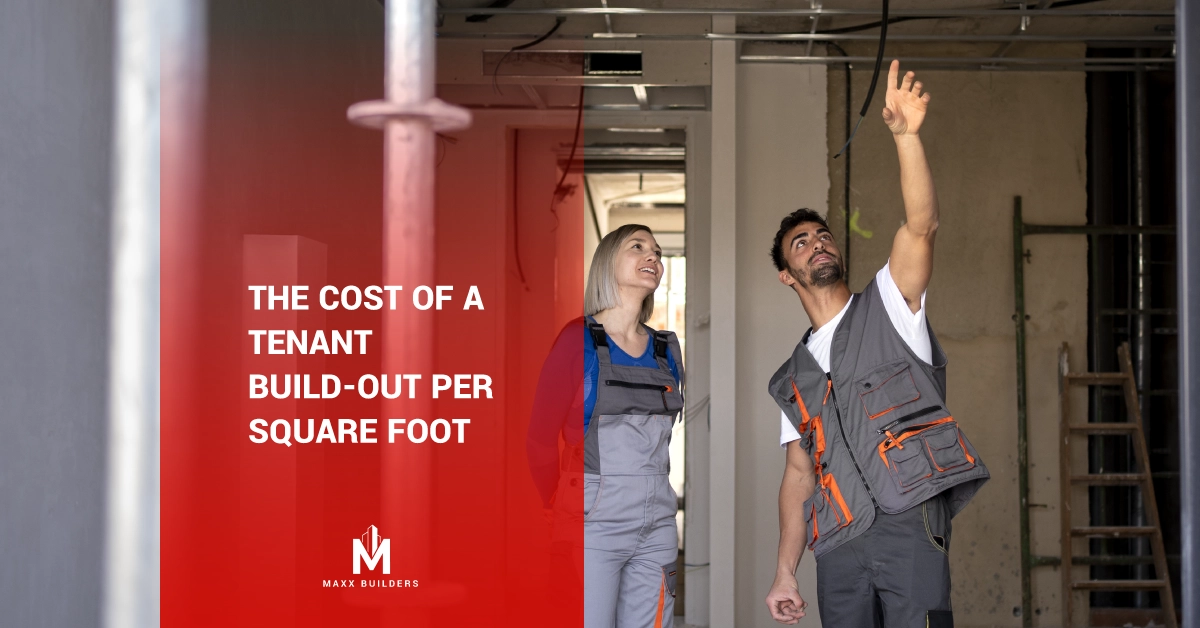Introduction
Embarking on a journey to customize a commercial space to suit your business needs can be both exhilarating and daunting. Whether you’re crafting the perfect ambiance for a boutique cafe, designing a cutting-edge tech startup office, or setting up a serene wellness center, the process of tenant improvements (TIs) is a critical step in transforming any commercial lease into your dream workspace. But, as exciting as it is to bring your vision to life, it’s the understanding of tenant improvement build-out costs per square foot that truly lays the groundwork for a successful project.
In the ever-evolving landscape of commercial real estate, where every penny counts and the right improvements can significantly impact your business’s bottom line, navigating the complexities of TI build-out costs becomes paramount. This guide aims to demystify the financial aspects of tenant improvements, providing you with a comprehensive understanding of how costs are calculated, influenced, and can be optimized to suit your budget without compromising on quality.
From the initial assessment of your space’s condition to selecting materials and negotiating with contractors, each decision you make has financial implications. With insights into national averages, budgeting strategies, and cost-saving tips, this article is designed to equip you with the knowledge to make informed decisions. We’ll explore the key factors that influence TI costs, offer guidance on negotiating lease agreements that work in your favor, and highlight the importance of prioritizing improvements for maximum impact.
What Are Tenant Improvements (TIs)?
When it comes to leasing commercial space, the term “tenant improvements” (TIs) frequently pops up, often surrounded by questions regarding budgets, design choices, and lease negotiations. Understanding what TIs entail and their significance in commercial leases can significantly impact your business’s functionality and aesthetic appeal. Let’s break down the concept and importance of tenant improvements in the realm of commercial real estate.
Definition and Scope
At its core, tenant improvements refer to the custom modifications made to rental spaces to accommodate the specific needs of the tenant. These changes can vary widely in scope and scale, from minor cosmetic updates like painting walls and installing new carpeting to major renovations that might include altering the layout, upgrading electrical systems, or even knocking down walls to create an open floor plan. The extent of these improvements is usually governed by the tenant’s vision for the space and the agreement reached with the landlord regarding who handles the costs and execution of these changes.
Why is this flexibility and customization so crucial? For businesses, the ability to tailor a space ensures that the operational workflow is optimized, the brand’s aesthetic is accurately reflected, and any specific technical requirements are met. This customization can range from installing specialized lighting for a retail store to soundproofing in a law office or customizing kitchen layouts for a restaurant. Essentially, TIs are the bridge between a generic commercial space and one that truly serves and represents your business.
Importance in Commercial Leases
The relevance of tenant improvements in commercial leases cannot be overstated. These modifications not only make a space functional for your specific business needs but also have the potential to significantly enhance the appeal and atmosphere of your business environment. For landlords, offering a TI allowance (a budget for the improvements) can make their property more attractive to prospective tenants, often resulting in a quicker lease agreement. For tenants, a well-negotiated TI allowance can mean a lower initial outlay of capital, preserving funds for other vital aspects of their business.
From a strategic standpoint, investing in the right improvements can dramatically transform a lackluster space into a vibrant, inviting venue that resonates with your employees and customers alike. This transformation not only contributes to a positive brand image but can also boost employee morale and productivity, attract more customers, and ultimately, enhance your business’s bottom line. Moreover, thoughtful improvements can lead to savings on operational costs, such as energy-efficient lighting and HVAC systems reducing utility expenses.
In the negotiation phase of a commercial lease, understanding the value and implications of tenant improvements is a powerful tool. It allows tenants to negotiate not just the cost but also the specifics of what will be done, who will oversee the project, and the timeline for completion. This clarity and agreement upfront can prevent misunderstandings and conflicts during the lease term, ensuring a smooth transition into the new space and a solid foundation for the business’s operations therein.
Key Factors Influencing TI Costs
When embarking on the journey of tenant improvements (TIs), understanding the factors that can sway your project’s cost is crucial for effective budgeting and planning. The expense associated with transforming a commercial space can vary widely, influenced by several key elements. Let’s explore the major factors that determine how much you’ll invest in customizing your leased space to fit your business needs.
The initial state of the commercial space you’re leasing plays a significant role in the overall cost of tenant improvements. Spaces are generally categorized into two types: shell space and second-generation (or previously occupied) space.
Condition of Space
- Shell Space: Often described as a “blank canvas,” shell spaces are essentially bare-bones structures with minimal or no interior finishes like flooring, ceilings, or wall coverings. While this might sound like a cost-saver, it actually means that you’ll need to invest more in basic infrastructure before even beginning to personalize the space to your needs. This includes electrical, plumbing, HVAC systems, and basic finishes, all of which can quickly add up.
- Second-Generation Space: On the other hand, a second-generation space, which has been previously occupied and fitted out, might already have many of the elements your business needs. Modifying an existing layout and updating finishes can be considerably less expensive than starting from scratch. However, the extent of modifications required to tailor the space to your specific needs will influence the final cost.
Complexity of Design
The ambition of your vision for the space can significantly impact your TI budget. Custom designs and intricate layouts that require specialized labor or unique architectural features will naturally increase costs.
- High-End Finishes and Features: Opting for premium materials and finishes, such as high-grade flooring, custom light fixtures, or specialty ceilings, can elevate the space but also your expenditure. Additionally, incorporating unique elements like custom millwork, specialized lighting designs, or advanced technological integrations can further amplify costs.
- Architectural and Engineering Requirements: Complex designs may also necessitate extensive architectural and engineering services, including detailed plans, permits, and inspections, which add to the project’s overall cost. The more specialized the design, the higher the fees for these professional services.
Material Selection
The choice of materials plays a pivotal role in both the aesthetic appeal and the cost of tenant improvements. Material costs can vary dramatically based on quality, durability, and source.
- High-Cost Materials: Luxurious materials like marble, granite, or high-end commercial grade carpets can provide a stunning look but come with a hefty price tag. Similarly, opting for custom cabinetry or imported tiles can significantly elevate costs compared to more standard, readily available options.
- Cost-Efficient Alternatives: On the flip side, selecting materials that offer durability and visual appeal without the premium cost can help manage expenses. Innovations in manufacturing have introduced a variety of high-quality, cost-effective alternatives, such as laminate flooring that mimics the look of real wood or engineered stone countertops as an alternative to natural stone.
In summary, the condition of your space, the complexity of your desired improvements, and the materials you choose to use are critical factors that will influence the overall cost of tenant improvements. By understanding and carefully considering these elements, businesses can make informed decisions that balance aesthetic and functional needs with budgetary constraints. The goal is to create a space that not only meets your business requirements but also reflects your brand identity without breaking the bank.
Average Costs and Budgeting
Embarking on tenant improvements (TIs) requires a clear understanding of costs and effective budget management. While the expenses can vary significantly based on factors discussed earlier, having a baseline understanding of average costs and how to budget for your project is essential. This section delves into the national averages for TI costs and provides guidance on crafting a budget that aligns with your vision and financial constraints.
National Averages
The cost of tenant improvements can swing widely, influenced by the scope of the project, location, and current market conditions. As of the latest data, national averages for TI costs range from $50 to $150 per square foot. However, these figures are just a starting point:
- Office Spaces: Generally, the cost to outfit office spaces can be on the lower end of the spectrum, particularly for projects with minimal structural changes and more focus on cosmetic updates.
- Retail Spaces: Retail setups, depending on the brand’s requirements for custom fixtures and fittings, can fall in the mid to higher range.
- Specialized Spaces: For businesses that require highly specialized improvements, such as medical facilities or high-tech labs, costs can exceed the upper average due to the need for specific materials, equipment, and infrastructure.
It’s crucial to note that these averages are just benchmarks. The actual cost for your project can vary based on local labor rates, the complexity of the design, and the quality of materials selected.
Budgeting for Your Project
Effectively budgeting for tenant improvements involves more than just accounting for the cost of materials and labor. To ensure your project stays on track financially, consider the following steps:
- Detailed Scope of Work: Start with a clear and detailed scope of work that outlines every aspect of the project. This should include all desired improvements, specifications for materials, and any unique features or requirements. A comprehensive scope will help prevent scope creep and ensure you get accurate quotes from contractors.
- Get Multiple Estimates: Once you have a clear scope, obtain estimates from several contractors. This will not only give you a more accurate picture of the potential costs but also provide leverage in negotiating the best possible rates.
- Consider the Total Cost of Ownership: Look beyond the initial investment to the ongoing costs associated with your choices, such as maintenance, utilities, and potential modifications. Opting for energy-efficient systems and durable materials can lead to significant savings over time.
- Contingency Fund: A common pitfall in TI projects is underestimating the costs and encountering unexpected expenses. It’s prudent to allocate a contingency fund, typically 10-20% of the total budget, to cover unforeseen issues that may arise during the renovation process.
- Negotiate with Landlords: Engage in negotiations with your landlord to understand what TI allowances or concessions might be available. In some cases, landlords are willing to cover a portion of the improvement costs, especially if the changes enhance the long-term value of the property.
- Review and Adjust Regularly: Your budget should be a living document, reviewed and adjusted regularly as the project progresses. Keeping a close eye on expenditures will help you stay on track and make informed decisions should priorities shift during the project.
- By understanding national averages and employing careful budgeting strategies, businesses can navigate the complexities of tenant improvements with greater ease and efficiency. The key is to approach the process with flexibility, foresight, and a willingness to adapt as necessary to ensure that your project not only meets your current needs but also positions your business for future growth.
Saving on TI Costs Without Cutting Corners
Creating the ideal commercial space for your business doesn’t have to break the bank. With strategic planning, savvy negotiation, and careful selection of your project’s components, you can significantly reduce tenant improvement (TI) costs while still achieving high-quality results. Let’s explore how to save on TI expenses without compromising the integrity and appeal of your space.
Negotiating Lease Agreements
One of the most effective ways to manage TI costs is during the lease negotiation phase. A well-negotiated lease can provide significant financial support for your improvements, either through a tenant improvement allowance (TIA) or by negotiating more favorable lease terms.
- Tenant Improvement Allowance (TIA): Many landlords are willing to offer a TIA to cover or contribute towards the cost of improvements. The key is to negotiate the amount and scope of work covered by the allowance. Be clear about your needs and how they align with the landlord’s interest in improving the property’s value.
- Rent Abatement: Another strategy is to negotiate rent abatement periods, where you pay reduced or no rent for a certain period during the TI process. This can free up cash flow to be redirected towards improvement costs.
- Capitalize on Lease Length: Longer lease terms can give you more leverage in negotiations. Landlords are often more willing to invest in TIs for tenants committed to a longer stay, as it ensures stability and reduces turnover costs.
Incorporating these strategies into your lease negotiations can lead to substantial savings, making it possible to invest more into the aspects of your space that will have the greatest impact on your business.
Selecting the Right Contractor
The choice of contractor can significantly affect both the cost and quality of your tenant improvements. Opting for the lowest bid isn’t always the best strategy, as it can lead to subpar work that costs more to fix in the long run.
- Get Multiple Bids: Collect bids from several contractors to ensure you’re getting competitive rates. However, don’t base your decision on price alone.
- Review Portfolios and References: Look for contractors with experience in your specific type of project. Reviewing their past work and speaking with previous clients can provide insights into their quality of work and reliability.
- Negotiate Payment Terms: Some contractors may offer discounts for upfront payment or have flexible billing that can help manage cash flow. Discuss payment schedules and any potential for cost savings with your contractor.
Selecting a contractor who understands your vision and budget can lead to better outcomes and help avoid costly mistakes or delays.
Prioritizing Improvements
Not all improvements offer the same return on investment, and prioritizing them can help you allocate your budget more effectively. Focus on changes that will have the greatest impact on your business operations, customer experience, and employee satisfaction.
- Must-Haves vs. Nice-to-Haves: Distinguish between essential improvements that will directly affect your business’s functionality and those that are more cosmetic or can be deferred.
- Impact on Business Operations: Prioritize improvements that enhance productivity, customer satisfaction, or revenue potential. These might include ergonomic workspaces, customer-facing elements, or energy-efficient upgrades.
- Phased Improvements: Consider a phased approach to your improvements, focusing on the most critical aspects first and planning for additional upgrades as your budget allows.
By negotiating effectively with landlords, carefully selecting the right contractors, and prioritizing improvements, businesses can significantly reduce the costs associated with tenant improvements. These strategies not only ensure that you can create a space that meets your needs but also do so in a way that is financially sustainable, allowing you to invest in your business’s growth and success.
Conclusion: Navigating the Complex Landscape of Tenant Improvement Build-Out Costs
Understanding the cost per square foot for a Tenant Improvement Build-Out is crucial for effective budgeting and planning. By considering the various factors that influence these costs and employing smart cost-saving strategies, you can make informed decisions that meet both your aesthetic and financial goals. Whether you’re a property owner, a leasing agent, or a prospective tenant, being well-informed about these costs can give you a competitive edge in the commercial real estate market.
Ready to Transform Your Commercial Space? Choose Maxx Builders for Your Next Tenant Improvement Project
You’ve navigated the complexities of tenant improvement build-out costs, and now it’s time to take action. Don’t leave your project to chance; choose a partner you can trust. Maxx Builders specializes in tenant improvement construction, offering unparalleled expertise and a proven track record of delivering projects on time and within budget.
Why settle for less when you can have the best?
- Expertise: Our team of skilled professionals knows the ins and outs of tenant improvement construction.
- Quality: We use only the highest quality materials to ensure your space not only looks good but lasts.
- Transparency: With Maxx Builders, there are no hidden costs. We provide detailed estimates that align with your budget and needs.
Contact Maxx Builders Today for a No-Obligation Quote
Ready to take the first step towards transforming your commercial space into a functional, aesthetically pleasing environment? Click the button below to get in touch with us for a no-obligation quote. Let Maxx Builders turn your vision into reality.
Your dream space is just a click away. Choose Maxx Builders—where quality meets affordability.



